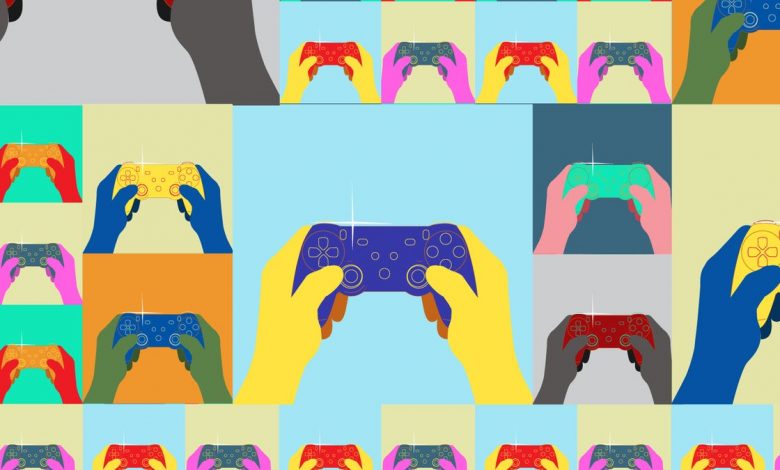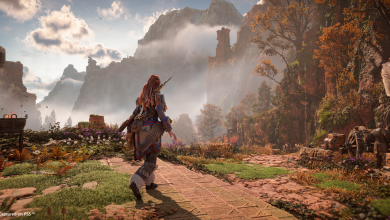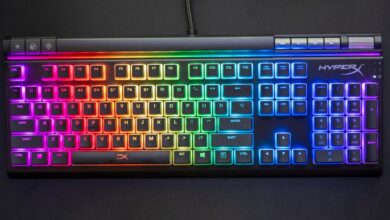The Video Game Industry Was Hot on NFTs. Then Came Hacks and a Market Meltdown

[ad_1]
It has all the hallmarks of a Pokemon game. You collect cartoonish creatures and use them to battle against other players. Some are rarer than others, inspiring envy in fellow trainers. But this game doesn’t run on a Nintendo console. It’s built on a blockchain.
In Axie Infinity, players put their team of Axies against an opposing player’s team. Each Axie is represented by lines of code in a game and doubles as an NFT, a nonfungible token that lets a player own a digital asset. Winning battles and going on adventures earns the player cryptocurrency called smooth love potion, or SLP, which can be sold for actual, real-world dollars. Players with two Axies can use SLP to breed more, which can then be sold to new players.
And this business can be lucrative. A Forbes article from March describes a burgeoning Axie Infinity economy, with a particularly vibrant outpost in the Philippines, that involves “life-changing” amounts of money that have “lifted [players] out of poverty.” One 22-year-old says he bought two houses with his winnings.
Of course, the world has changed dramatically — both for Axie Infinity and, more broadly, the cryptocurrency and NFT markets — since that article and YouTube video were published. Days after the Forbes article ran, North Korean hackers stole roughly $620 million worth of cryptocurrency from the network used to process Axie’s in-game transactions, prompting the game’s owner, Sky Mavis, to take the Ronin Network, a major transaction-processing sidechain, offline. Last month, the Ronin Network reopened, and reported that it had begun reimbursing victims of the theft, according to a blog posted on its Substack.
Sky Mavis didn’t immediately respond to a request for comment.
Since the attack, however, the price of ethereum — a popular cryptocurrency used to facilitate Axie’s economy — has plummeted, losing roughly two-thirds of its value. As such, victims of the hack will recover approximately one-third of their losses. And that development underscores what may be the greater challenge for Axie Infinity, Sky Mavis and the broader intersection of crypto and gaming — the current “crypto winter” that has cratered the value of major cryptocurrencies including bitcoin and ether, decimated alternative tokens and stablecoins and demolished much of the markets’ enthusiasm for NFTs.
Still, the integration of NFTs and cryptocurrencies into gaming will surely persist in some form, despite the current challenges before the industry. Video games — and the crypto-infrastructures being built up around them — take time to develop, and won’t necessarily be canceled immediately. Established players in the industry like Square Enix and Sega have expressed interest in using NFTs in upcoming titles, and Ubisoft has already integrated them into one of its key games, Ghost Recon Breakpoint.
As cryptocurrency prices soared in late 2021 and early 2022, companies in nearly every industry worked to figure out how to fit the technology into their business. Gaming studios were no exception. But the question remains: Will blockchain-integrated games like Axie Infinity mark the dawn of a new gaming era — or become poster children for yet another crypto-inflated bubble? The question is as contentious as cryptocurrency itself.
Playing to earn vs. playing for fun
NFTs are polarizing.
NFTs entered the cultural mainstream in 2021 as a novel method of determining ownership of digital property using blockchain technology. As cryptocurrencies like bitcoin and ether skyrocketed to all-time highs, newly minted crypto millionaires began speculating on NFT digital art. People pay eye-popping prices to own digital pictures — think $250,000 for a colorful ape avatar — and the NFT speculation market is now at a fever pitch, with celebrities like Snoop Dogg and Ellen DeGeneres putting their names behind NFT collections.
At the time, critics dismissed NFTs as an energy-intensive fad — a view that has gained momentum as valuations have fallen. Still, proponents argue that NFTs mark a new cultural shift that will upend digital ownership. Whether you find NFTs compelling or absurd, or simply don’t get it at all, the video game industry is embracing them — and cryptocurrencies — as the next big thing.
The question gaming companies are trying to work out is how to best use the tech. First there’s a soft integration, where players can own digital goods, like costumes or weapons, as NFTs instead of leasing them from merchants like Epic Games, as is currently the case. Then there’s the play-to-earn, or P2E, model, where blockchain assets that have value outside of the game, such as cryptocurrencies, are earned via gameplay.
Axie Infinity exemplifies the P2E trend, along with games like Guild of Guardians and Galaxy Fight Club. For a time, players found different ways to earn a living off the game. Some farmed SLP tokens, bred Axies and sold them to players. With the game’s patronage system, some experienced players lent out their Axies to new players and took a cut of the profits, kind of like a taxi company lending cars to drivers. Virtual land in the game was sold for thousands, or even millions of dollars’ worth of cryptocurrency.
In October, the game’s 1 million-plus daily players drove nearly $29 million per week in revenue for Sky Mavis, the company that owns and runs Axie Infinity. Those days are over for now. The NFT market’s disintegration has significantly eroded traffic, and the game’s number of daily active users decreased from 2.7 million in November to less than 700,000 in late May, according to Bloomberg.
Whether games like Axie Infinity are economically sustainable is still up for debate. But with fewer new players joining, there are now fewer customers for Axies, and SLP tokens have become nearly worthless. Even during the boom times, new players had a much harder time making cash than those who joined early. Since Axie Infinity has stopped generating revenue for players, there’s now less of a reason to play.
“It’s better to have a normal amount of players that you can reasonably keep interested and engaged in the game,” said Andrius Miron, who runs Gamestarter, a blockchain-based crowdfunding platform for indie games. “This is the part where I’m not super excited about Axie Infinity, because I believe their game is mostly focused on the money-making machine aspect rather than gameplay itself.”
Reevaluating ownership in the digital age
Talk to blockchain evangelists and they’ll say that NFT technology isn’t about profit-seeking, but digital ownership. This is the same pitch gaming giants may increasingly be making to their players. In-game items will soon be sold as NFTs, which, unlike microtransactions of the past, can be traded for other digital goods or sold to other players for money.
That people are eager to pay real-world money for in-game items isn’t up for debate. Over $90 billion was spent on microtransactions in 2021, according to Super Data research, much of which came from gamers treating themselves to new costumes or weapon skins. Particularly passionate players are also willing to pay high sums for rare items.
A few years back, an item that alters the appearance of your rifle in the popular game Counter-Strike went for just over $61,000 at auction. The scarcity of the item and the popularity of the game meant that someone was willing to pay more than many Americans make in a year for the privilege of ownership. And in 2012, a weapon for the game Diablo III netted 7,500 euros (over $8,000) at auction. It’s a well-documented phenomenon now for rare items in popular video games to sell for uber high prices.
“The games industry has long created digital assets and sold them inside games,” said Michael Pachter, a video game analyst with Wedbush Securities. If the trend for such transactions moves toward the blockchain, Pachter said, that’s where the big companies will go.
While many of the huge gaming companies have spoken about integrating NFTs into their games, Ubisoft, the company behind franchises like Assassin’s Creed and Far Cry, is the first to actually do it. In December, Ubisoft integrated NFTs into squad shooter Ghost Recon Breakpoint.
In Breakpoint, players can own NFTs called “Digits” independent of the game. Because the Digit is a digital asset minted on a blockchain, it’s stored in your digital wallet rather than on Ubisoft’s servers. If the Digit increases in value by becoming a cult item, or if only a small number are in circulation, you can sell it on a third-party marketplace. In this way, game developers across the globe are hoping to entice players with true ownership of highly sought after and valuable in-game items.
But how well NFTs will function in games — and whether or not gamers will abide by this trend — is still playing out. The reaction to Ubisoft’s NFT experiment has been overwhelmingly negative.
The YouTube video announcing Ubisoft’s NFTs received less than 2,000 “likes” and over 40,000 “dislikes,” and few players are buying the NFTs. As of December, Ubisoft had sold fewer than 20 NFTs. Sega, another game company with a household name, has noticed gamers’ outcry against NFTs and is taking a measured approach to the technology, with Sega management saying they wouldn’t pursue NFTs if the approach was seen as “simple money-making.”
Ubisoft didn’t immediately respond to a request for comment.
It’s still anyone’s guess which game developer will properly integrate NFTs into video games in a way that makes waves in the multibillion-dollar business while also connecting players with one another.
“We’re trying to describe Amazon in 1993, before it was created,” said Pachter. The digital world moves fast, and the dominant players can easily change. Pachter cites the early days of the internet as an example: “If you had asked me in 1993, ‘This internet thing, who wins?’ I would have said AOL. Because they were the dominant player.”
Gaming companies are split
Just because NFTs can go in video games doesn’t mean they should. This is the view not just of concerned experts, but also some gamers themselves.
And while many in the industry are open to NFT integration, it’s not universal. Phil Spencer, Microsoft’s head of gaming, says he’s wary of NFTs. Steam, one of the largest digital video-game stores in the world, outright banned blockchain-related video games. When you account for the negative backlash Ubisoft received for introducing NFTs in Ghost Recon, its trepidation toward blockchain technology makes perfect sense.
More than half of game developers are interested in NFT and blockchain technology, according to a survey published in November 2021. One assumes that enthusiasm has now been tempered. If the Axie Infinity flameout and Ubisoft backlash are taken as warnings, this era of gaming may be short-lived. But whether or not NFTs become a lasting trend in the gaming world will depend on the gamers. As always, the players will decide.
This story was originally published in January 2022 and updated in July 2022.
[ad_2]
Source link






